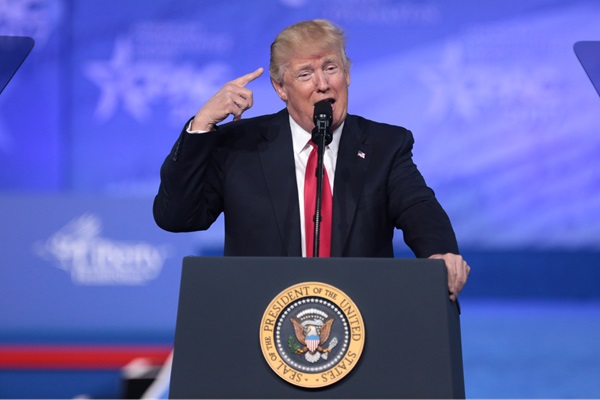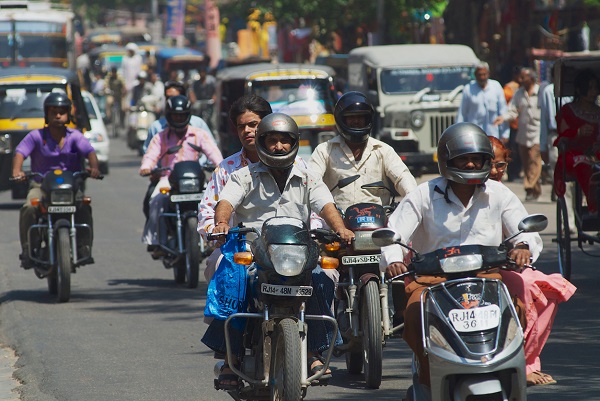.png)

Groupthink is the House View of BasisPoint’s in-house columnists.
April 1, 2025 at 10:53 AM IST
The unveiling of US President Donald Trump's reciprocal tariff plan on Wednesday introduces considerable uncertainty and potential challenges for India's businesses, especially those with significant exposure to the US economy.
While the exact nature and extent of these reciprocal tariffs remain to be fully revealed, Trump has said that these would apply to "all countries" with trade imbalances with the US, indicating he might move away from his earlier intentions to target only select nations.
A recent report by S&P Global Ratings said India, South Korea, and Thailand could be the most vulnerable to these tariffs.
The core rationale behind these reciprocal tariffs, as Trump has argued, is that the US charges lower tariffs compared to its trading partners, leading to a substantial trade deficit – of about $1 trillion – that harms American industries and workers.
Trump’s plan aims to raise tariffs or import duties on countries with which the US has a trade deficit. However, the specifics of how these reciprocal tariffs would be applied remain unclear.
It's uncertain whether the tariffs would be implemented uniformly across all Indian exports, applied separately to agricultural and industrial goods, or levied at a more granular sector or product level. This ambiguity makes it challenging to precisely calculate the potential impact.
If a reciprocal tariff is applied uniformly to all Indian exports, it could result in an additional 4.9% duty, based on the current difference between the weighted average tariffs faced by US goods in India (7.7%) and Indian exports to the US (2.8%), according to an analysis by Global Trade Research Initiative, a New Delhi-based think tank.
That, however, is a remote possibility. Most expect the tariffs to vary from sector to sector, product to product.
Agriculture vs. Industry:
If separate tariffs are imposed, agricultural products could face an additional 32.4% tariff, while industrial goods might see a 3.3% increase. Sectors like fish, meat, and processed seafood are projected to be the hardest hit in agriculture, facing a significant 27.8% tariff differential.
Incidentally, as the latest data shows, while India’s overall merchandise exports contracted in February, marine products bucked the trend, emerging as a new area of growth for Indian exports.
Processed food, sugar, and cocoa exports might face a 25% tariff increase. Dairy products could be severely affected by a 38.23% tariff differential. Even exports of cereals, vegetables, fruits, and spices face a notable tariff differential.
That said, it is not the impact on India’s agricultural exports that’s troubling its government. The fear is that Trump may try to use the threat of higher tariffs on industrial goods of India’s interest to force it to throw open agriculture to American exports.
The weighted average tariff on the US farm products in India is 37.7%, compared to just 5.3% on Indian agricultural goods in the US, highlighting the asymmetry that Trump's tariffs might aim to address.
The US has long sought greater access to India’s farm sector, pushing for exports of wheat, cotton, corn, and maize. However, India has fiercely protected this sector citing food security and the livelihoods of millions of small farmers.
More importantly, Washington’s attempts to force concessions in this respect undermine the World Trade Organisation that allows developing economies like India to extend disproportionately higher protection to agriculture.
Should India choose not to budge on agriculture, it is likely that the Trump administration will seek to target Indian exports of industrial goods.
Sectoral Headwinds
Several sectors in India might experience significant disruptions if Trump's reciprocal tariffs materialise.
- Engineering Goods: Exporters in the engineering goods sector, particularly those dealing with iron, steel, and aluminum products, are already feeling the heat. Shipments worth $5 billion are reportedly on hold as the US buyers await price adjustments in anticipation of a potential 25% additional levy, the Times of India reported Tuesday.
- Apparel: American garment buyers have reportedly begun demanding discounts from Indian exporters in anticipation of higher tariffs. The Apparel Export Promotion Council has voiced deep concerns about the adverse impact on apparel trade with the US and is hoping for government intervention to defer the application of these tariffs on India.
- Pharmaceuticals: As India's largest industrial export, the pharmaceutical sector, shipments worth $12.72 billion, could face a 10.90% tariff differential, potentially increasing the cost of generic medicines and specialty drugs in the US.
- Gems and Jewellery: Exports of diamonds, gold, and silver, valued at $11.88 billion, might attract a 13.32% tariff hike, reducing competitiveness.\
- Automobiles and Auto Components: This sector already faces a 25% tariff announced in March. While India's direct car exports to the US are relatively low (around $9 million last year), its auto parts exports are worth about $7 billion, could face tariffs from May. Furthermore, there is pressure on India to lower its tariffs on imported American cars, a move that could be detrimental to India's thriving domestic auto industry. High tariffs in the past have been crucial in attracting foreign investment and fostering a robust auto and auto components manufacturing base in India.
India’s Options
New Delhi has been actively seeking to pre-empt any reciprocal tariffs by the Trump administration. It is open to cutting tariffs on over half of US imports worth $23 billion, according to a Reuters news report.
Continuing dialogue and seeking exemptions or a deferral of tariffs remains a crucial strategy. Stakeholders are hopeful that ongoing trade agreement negotiations might lead to a more favourable outcome. India might need to consider offering concessions in certain sectors where the impact on the domestic industry is minimal in exchange for tariff relief in more vulnerable sectors.
Both sides are trying to hammer out a sector-specific trade deal that may go into effect. Indian businesses hope that the prospects of such a deal may persuade Trump to hold back on tariffs against India, for now. But progress on the proposed deal, expected to go into effect later this year, has been slow.
If negotiations fail and tariffs are imposed, the Indian government might need to consider measures to support affected industries, such as providing financial assistance or exploring retaliatory tariffs. Needless to say, the latter could escalate trade tensions and New Delhi must be prepared for it.
It will also need to prioritise market diversification and reduce its reliance on the US market. Exploring new trade opportunities in other regions could mitigate the impact of potential US tariffs.
The most important lesson for India should, however, be that it urgently needs to focus on enhancing the competitiveness of its industries through improved infrastructure, technology adoption, and reduced production costs.
This will help them remain attractive to buyers even with potential tariff increases. In agriculture, this means modernising practices, improving productivity, and strengthening market access.
It’s time we stopped sheltering under the shadow of tariffs.




